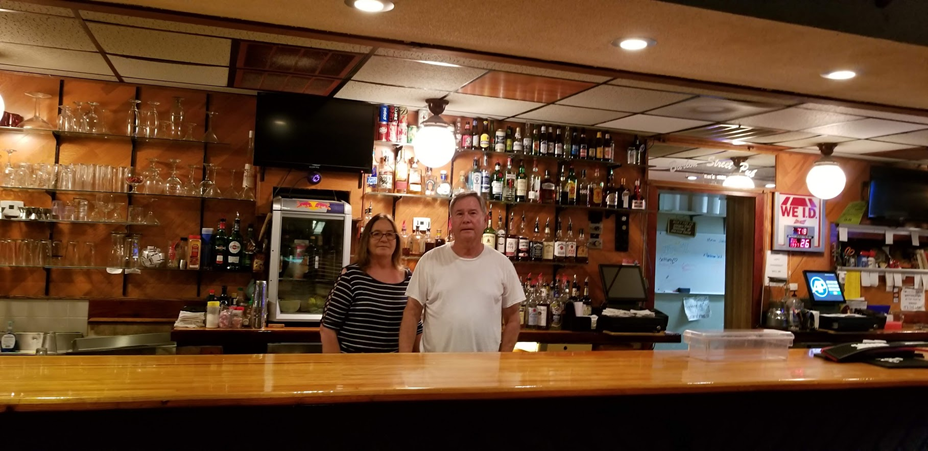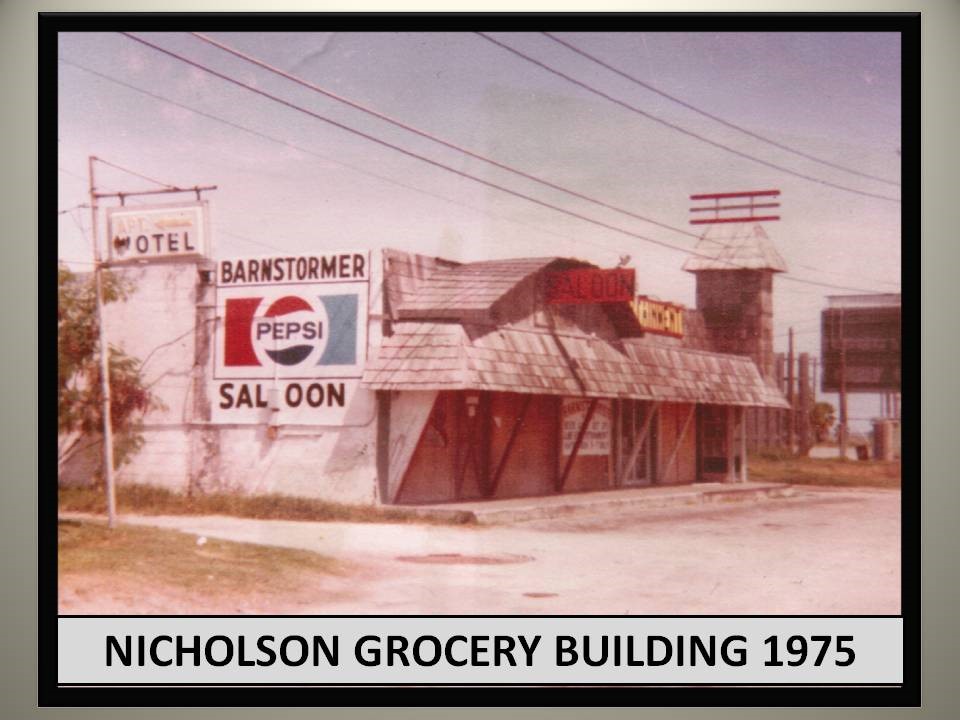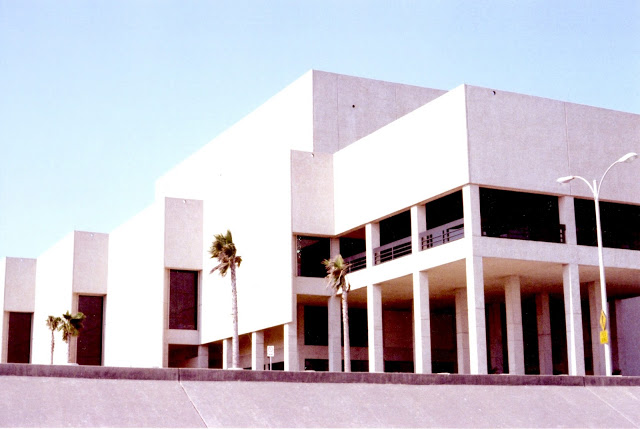
Lisa and John Nicholson standing at bar in Barton Street Pub. The bar top was once Lane 48 at Buccaneer Bowl. (Photo by Shirley Thornton)
Telling the Rest of the Story

Lisa and John Nicholson standing at bar in Barton Street Pub. The bar top was once Lane 48 at Buccaneer Bowl. (Photo by Shirley Thornton)
In Part III of the Nicholson story, we learned that John Orval Nicholson III (Johno) ran his store on the island at the Nueces-Kleberg county line from 1975 to 1977. When a tropical storm flooded the area and destroyed the building, he and his wife Lisa turned their focus to a project already in the works. They were converting the Nicholson’s Grocery building at 338 Davis Drive (which by then was 10618 S Padre Island Drive) into a bar, The Barnstormer. The years leading up to 1975 were hard ones though, years when it seemed the family would not be able to keep the store started by his grandpa going.
In 1969, Johno was running Nicholson’s Grocery with his mom. He was nineteen years old. He tried just about everything to keep the family grocery store open, including renting televisions. “I had a friend who gave me an extra tv that she had, and I put it in the store. Somebody saw it and suggested I rent it out, which I did,” Johno said. “We couldn’t keep it. It stayed rented, so I went to Aldridge TV – which was owned by people my dad knew when he was in the tv repair business – and bought a couple more. Boom! I’d rent them out. I bought a couple more. Boom! I’d rent them out. I couldn’t believe it! Because of my age, I couldn’t get credit to buy more televisions, so I asked Mother to co-sign. She said no way was she co-signing a note for televisions sets. Well, at the end of the week, I showed her how much money I made on the few televisions I had, and she signed the note dadgum quick!”
This brought Johno’s television count to about fourteen. “I even had some color tvs,” Johno said. “I ended up with 36 televisions, and one of them even had a remote. That business ran well for a few years until people were able to afford to buy their own tvs.”
When the television rental business was really going, Johno added another service to help keep the store alive. He started selling ice. “Tom Hale, who owned Ira’s, sold me an icemaker for a hundred dollars. It needed some work, but I was pretty good at refrigeration, so I fixed it up and started selling ice,” said Johno. “We were making a thousand pounds a day. Mom Collins, who owned Mom’s Galley and Collin’s Catering, was buying ice from me at the time. She’d back her catering trucks up here every morning, and we loaded them up. Maureen Gasser, who owned the liquor store at South Gate was an ice customer, too. I went to San Antonio to buy ice coolers to put on location at her place and at B&B Tackle, Bob Hall Pier, John Bean Pier (where Snoopy’s is now), and a few other bait stands like Graham’s Bait Stand.”
Unbelievably, business was so good, that Johno had to end Southwest Ice and Television. “We just couldn’t keep up,” he said.
Another business came Johno’s way while the grocery store was still open. This time, he was making and selling fruit baskets for $5 each. “The Padre Island Investment Corporation was putting people up in the Million Dollar Inn and taking them out to show them property on the island,” said Johno. “They came to me and asked if I would make up some Mexican hats with cheese, crackers, a couple of pieces of fruit, and some candy to be delivered to the rooms of the potential buyers. We made good money on the baskets.”
Still, they struggled to keep the store open. “We discounted everything in the grocery store and sold it all out,” said Johno. “We got the bar up and running, and it was doing pretty well.”

The transition period at the Nicholson’s Grocery building, ca. 1975 (Photo courtesy of John Nicholson)
Johno and Lisa opened all but a small part of the building for the bar and looked for ways to attract business. “We didn’t have a cover charge. We tried to charge fifty cents, and no one would pay it, so we gave that up,” he said. “We booked live bands, which was really popular back then. We sold 10-ounce draft beers for 25 cents from 5:00 to 7:00,” said Johno. “Then at 7:00, we went to 12-ounce beers in frozen mugs for 50 cents. We only sold Schlitz, 35 kegs a week. That comes to 8,897 beers a week.”
All was going well. Then, April 1, 1978, disaster struck when a fire damaged the building, and they had no insurance. “Lee Huegele, who owned the car wash, gave us $1000 to help us out. And, for some reason I had made application to be the concessionaire at the Bayfront Plaza Auditorium,” Johno said. “I don’t know why I did; maybe it was Divine intervention because I did it before the fire. The fire was April 1st, and we got the contract on the auditorium October 1st. We were the first concessionaire at the convention center.”
Johno recalled the many events in those early days from symphonies to country and western bands to top acts like Johnny Mathis. “The symphony crowd wasn’t too good. They were kind of tightwads. I guess that’s why they had money,” said Johno with a chuckle. “Johnny Mathis was one of the big names. I got to meet him. His people called ahead and made special requests for refreshments in his dressing room for the people he invited. I supplied all the refreshments. He was a pretty nice guy.”

Bayfront Plaza Auditorium, 1982. (Kenneth L. Anthony Photographic Collection, Item 212-84. Special Collections and Archives, Mary and Jeff Bell Library, Texas A&M University-Corpus Christi.)
The money made at the auditorium came through direct food and drink sales and a contracted percentage of anything sold by the performing company. “If they sold t-shirts, then I earned a percentage of the take,” recalled Johno. “That meant that I had to count their inventory before and after the show. Most groups were really good about honoring the contract. Some tried to stiff us, but the management at the auditorium would help us out since the contracts were made through the city. They even blocked a bus once of a group that tried to slip out without paying.”
“It was a lot of work. The convention center was busy all the time then, so we were busy,” Johno said. “Any meeting or party or event of any kind meant we were working. It was more than a full-time job. We even catered to the city council the first Tuesday of every month. We turned out some really good food for them at ten dollars a head. During that 3 ½ years, we also worked as employees for Margie Bennett, who had the concession contract at the Memorial Coliseum. When she quit, we had it for a couple of weeks on our own. Wrestling and Golden Gloves boxing events brought us a lot of business.”
Johno continued, “We stayed there for three and a half years and earned $20,000. That’s was more money than I had ever seen. We used it to repair the Barnstormer, and we did get it dried in with the help of a lot of friends who had different construction skills.”
“I knew that money wouldn’t go very far,” Johno’s wife Lisa added, “so I got a job at Taco Fiesta immediately.”
“She is a lot smarter than I am,” Johno said with a smile.
“I still had my liquor license on hold from the auditorium, so I started looking for a place to use it until we got the Barnstormer ready to open,” said Johno. “We ended up leasing the building at 9901 South Padre Island Drive, which sits at the corner of SPID and Barton Street and is now the granite store. The building had housed a bar called the Black Hole. We fixed it up and renamed it Barton Street Pub. They gave me free rent as long as we were fixing it up.” Johno said that they sublet a piece of the bar to Dave and Darlene Duncan for a sandwich shop named Pub Grub. Darlene’s dad, Burt Adams, had once owned the Villa Italiano.
The renovation took six months. “It was a nasty place with black walls and restrooms that had to be completely redone,” said Johno. “We built the bar and really did a nice job on the building. In the meantime, I was also working construction with Doug Turner. We opened Barton Street Pub on June 19, 1982.”
In the late 1980s, Johno and Lisa took on yet another venture to help pay the bills. This time it would take them all the way to Laredo, Texas, on the Tex-Mex Express. When this little tourist train business opened, Johno and Lisa joined forces with Evelyn Silvertooth, owner and operator of Sonja’s Bakery on NAS Drive. “She did the sandwiches and pastries, and we took care of the drinks,” Johno said. “It only ran February through August. People bought round-trip tickets and could come back on Friday, Saturday, or Sunday. We had it for two years.”
Johno and Lisa ran the bar at the Barton Street location for 10 years. “The lady who owned it sold the building, and we just about had the Barnstormer rebuilt, but we needed more money to get it finished,” he said. “I borrowed $50,000; it was a fortune to me. I would buy what I needed then take in a receipt to get the money released. By the time I finished the renovation, I had spent $48,850. I gave back the remainder. I didn’t want to owe any more than I had to.”
Johno saved in every way he could while rebuilding the Barnstormer. “I heard the Buccaneer Bowl was closing, so I went down there a salvaged a few of the lanes. I needed a bar top,” Johno said, “and Lane 48 didn’t have many dings since it was next to the wall, so I got it to use as the bar. We had it cut to 40 feet and added redwood to the edges.”
The pub was up and running in 1989 and doing well, but the need for money to pay off debt, finish the bar, and take care of four children was still there. “I had an old friend who had a loan service business who hired me to mow yards for $30 apiece. I had some time in the afternoons, so I borrowed a mower from Mr. Huegele who owned the car wash next door and took the job,” Johno said.
“Soon we were asked to clean the properties. We trimmed trees and shrubs, cleared out the trash, and did whatever needed to be done. After a while, they asked us to deliver late notices to property owners. It started with just a few each day, and before long we were doing a 100 a day easily. We made $4.50 for each delivery,” Johno explained. “We had to use our own vehicles. I was driving 60,000 miles a year delivering to areas like Riviera, Bishop, Kingsville, Port Aransas, Aransas Pass, Beeville, Alice, and Riviera while Lisa was driving 30,000 miles working in town. We hired office personnel to keep up with the paperwork involved with the job. We had to submit paperwork every day. We did it by U.S. Mail in the beginning. By the end, we were submitting by computer. Of course, we were also paying people to tend bar while we ran the other business.”
The job could be a little scary, too. Once a lady got upset with Lisa for delivering the late notice and wouldn’t allow her to leave. The woman called the police. When the officer arrived, it was one of the young men who had worked for her and Johno years before collecting late fees for televisions and delivering ice and fruit baskets. He had become a Corpus Christi police officer. “I wasn’t doing anything illegal, and he explained that to the lady. I was so happy to see him!”
Later Johno added Laredo to his route. “NAFTA created a situation where people suddenly had money and started buying new houses they couldn’t really afford, so work was opened up in Laredo,” said Johno. “I got paid a little more because I was driving 450 miles round trip. That job helped us get on solid financial ground. We gave it up in 2015. Now, we come in at 7:30 a.m. and clean, stock, and fix. I’m in charge of dirty and broken, and she [Lisa] is in charge of money.”
What this couple born in the 1950s did to make a living, raise a family, and hold on to the property originally bought by Johno’s grandfather in the 1940s is reminiscent of the spirit of those of the Greatest Generation who survived the Great Depression and World War II. They didn’t always have the money to do it, but with help from God and friends like Lee Huegele and Margie Bennett, Johno and Lisa would eventually buy all the family property back – and then some. Through lots of hard work and tightening of belts, Johno and Lisa are happy to say that they are down to one job, managing their property, enjoying traveling and spending time with grandchildren, and visiting with old friends and new who drop by Barton Street Pub.
When asked what he thought about his struggles to keep and improve the land in Flour Bluff his grandfather left him, Johno smiled and said, “I enjoyed every bit of it.”